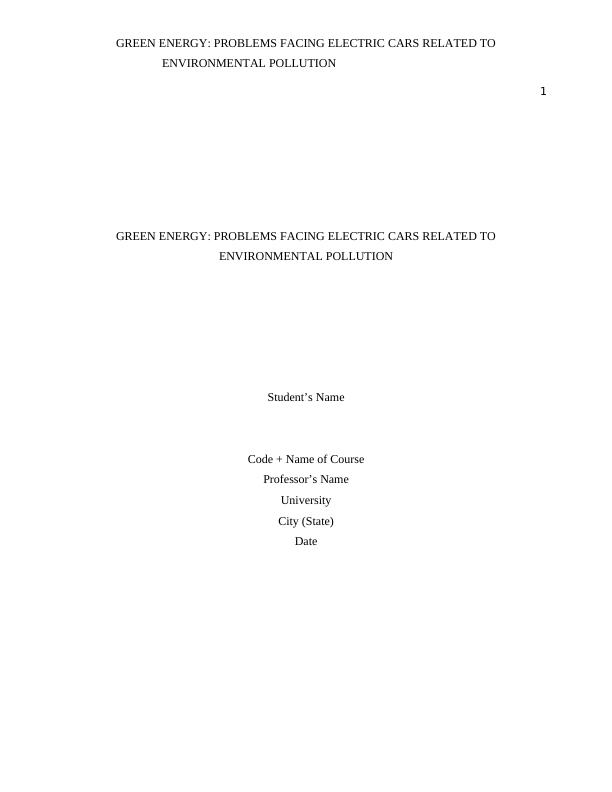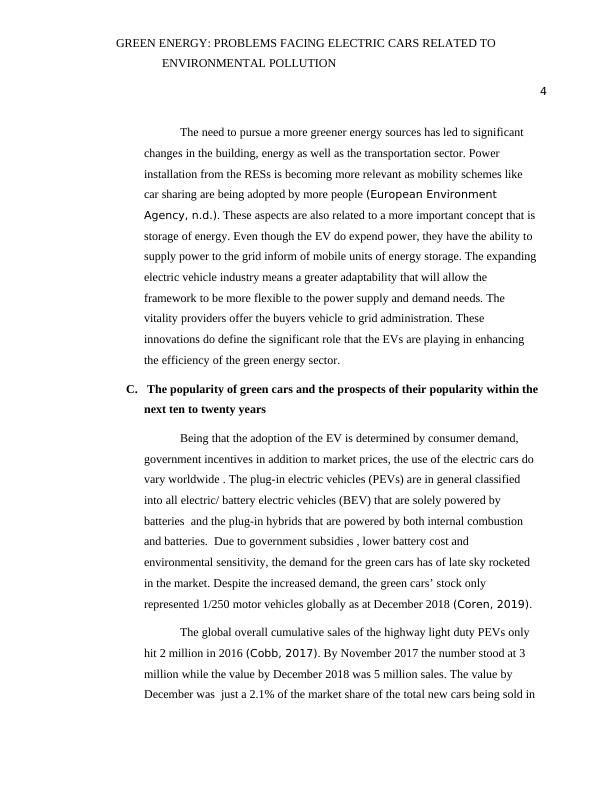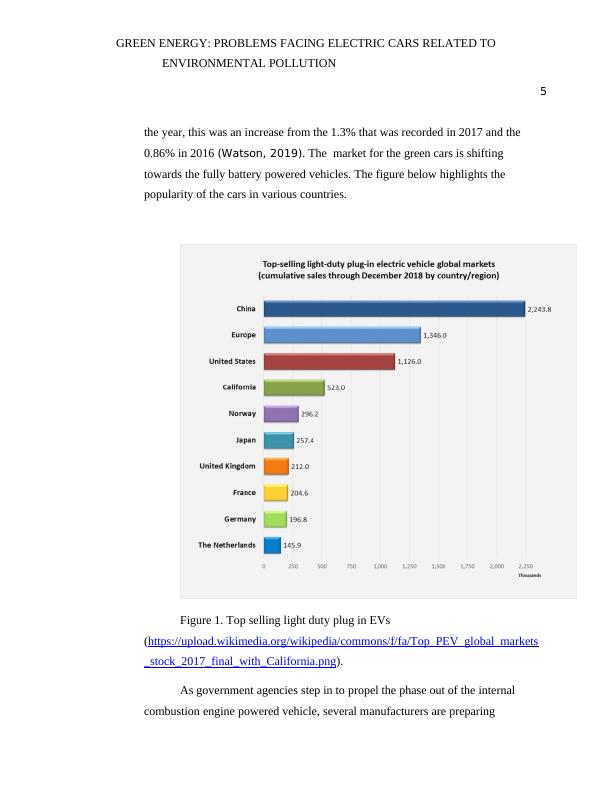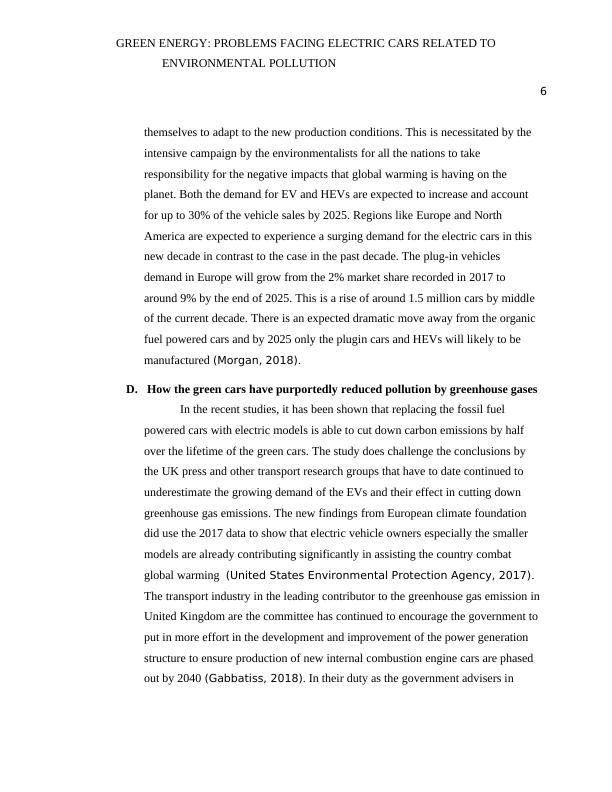PROBLEMS FACING ELECTRIC CARS
Added on 2022-08-22
21 Pages5959 Words18 Views
GREEN ENERGY: PROBLEMS FACING ELECTRIC CARS RELATED TO
ENVIRONMENTAL POLLUTION
1
GREEN ENERGY: PROBLEMS FACING ELECTRIC CARS RELATED TO
ENVIRONMENTAL POLLUTION
Student’s Name
Code + Name of Course
Professor’s Name
University
City (State)
Date
ENVIRONMENTAL POLLUTION
1
GREEN ENERGY: PROBLEMS FACING ELECTRIC CARS RELATED TO
ENVIRONMENTAL POLLUTION
Student’s Name
Code + Name of Course
Professor’s Name
University
City (State)
Date

GREEN ENERGY: PROBLEMS FACING ELECTRIC CARS RELATED TO
ENVIRONMENTAL POLLUTION
2
I. INTRODUCTION
A. The Background: The extent and effects of pollution by the organic-fuel
powered cars
One of the leading concerns in the transport sector is the negative impacts
that the organic fuel-powered cars have on the health of plants and animals.
Studies conducted in the recent decade shows that outdoor air pollution have an
adverse effect on the health of humans. Evidence supports the notion that air
pollution originating from transport is one of the primary contributors (Iannone,
et al., 2011). Road transport is expected to retain its leading role as the major air
pollutant in most of the cities across the globe. Urban trips cover averagely 6 km,
since the catalytic converters are less effective in the initial minutes of starting the
engine, emission per distance in the cities tend to be averagely high. Also, cars
that are poorly maintained and lack proper functioning exhausters are responsible
for major part of emission of pollutants (Alexander & Schwandt, 2019).
Traffic contributes to a range of gaseous air pollutants and suspended
particulates of various sizes. Tailpipe emissions of particles from road transport is
responsible for up to 30% of the total primary particulate pollution in the cities
across the continent. Other emissions that are attributed to organic fuel powered
cars such as suspended road dust, tire and brakes are also significant causes of
coarse fraction primary particles. Road transport is also responsible for most of
the nitrogen dioxide and benzene. This is one of the reasons why nations are
struggling to comply with the European Union limits for the various air pollutants
(Shuhaili, et al., 2013).
There is evidence to support the notion that transport related air pollutants
are the main contributors to the increased health risks such as cardiopulmonary
cases. The pollutants do increase the risk of respiratory complications that are not
allergy related. Experimental studies have shown that the effects are positively
correlated to the change in the formation of reactive oxygen species, changes in
the antioxidant defect and the increased inflammation thus providing indications
ENVIRONMENTAL POLLUTION
2
I. INTRODUCTION
A. The Background: The extent and effects of pollution by the organic-fuel
powered cars
One of the leading concerns in the transport sector is the negative impacts
that the organic fuel-powered cars have on the health of plants and animals.
Studies conducted in the recent decade shows that outdoor air pollution have an
adverse effect on the health of humans. Evidence supports the notion that air
pollution originating from transport is one of the primary contributors (Iannone,
et al., 2011). Road transport is expected to retain its leading role as the major air
pollutant in most of the cities across the globe. Urban trips cover averagely 6 km,
since the catalytic converters are less effective in the initial minutes of starting the
engine, emission per distance in the cities tend to be averagely high. Also, cars
that are poorly maintained and lack proper functioning exhausters are responsible
for major part of emission of pollutants (Alexander & Schwandt, 2019).
Traffic contributes to a range of gaseous air pollutants and suspended
particulates of various sizes. Tailpipe emissions of particles from road transport is
responsible for up to 30% of the total primary particulate pollution in the cities
across the continent. Other emissions that are attributed to organic fuel powered
cars such as suspended road dust, tire and brakes are also significant causes of
coarse fraction primary particles. Road transport is also responsible for most of
the nitrogen dioxide and benzene. This is one of the reasons why nations are
struggling to comply with the European Union limits for the various air pollutants
(Shuhaili, et al., 2013).
There is evidence to support the notion that transport related air pollutants
are the main contributors to the increased health risks such as cardiopulmonary
cases. The pollutants do increase the risk of respiratory complications that are not
allergy related. Experimental studies have shown that the effects are positively
correlated to the change in the formation of reactive oxygen species, changes in
the antioxidant defect and the increased inflammation thus providing indications

GREEN ENERGY: PROBLEMS FACING ELECTRIC CARS RELATED TO
ENVIRONMENTAL POLLUTION
3
of mechanisms of susceptibility. Studies have also attributed the increased cases
of lung cancer in people to their increased exposure to pollutants originating from
air transport (EnergySage, 2019). The named examples are just but a few of
the limitations of organic fuel powered cars that research have been able to
highlight. The severity of the cases is enough reason to input more resources into
alternative cars.
B. How the invention of the electric cars revolutionised the green energy sector
The use of the electric vehicles in combination with wind power has been
proven by research to be ideal for provision of ancillary services. The electric
vehicles (EV) ought to be coordinated to enhance high value services examples
the ancillary services that reduces the cost of operation to the vehicle owners in
the short term. Even though the vehicles have high initial costs, their overall
prices are though lower when compared to the ICE cars. EVs are able to control
power mismatch that results from the variability of wind power hence eliminating
the utilisation of conventional power plants (Longo, et al., 2018). Large
amount of clustered EVs and other households’ items can be used to offer
secondary reserves in the power system.
Furthermore, studies looking into the integration of the EV with solar
power have clarified that it is possible to generate electricity PV at both the
medium and low voltage levels in the power system. Utilisation of the electric
cars in the grid distribution process is considered as an alternative to energy
storage instead of using the controllable loads. Research also indicate that during
day time when there is maximum solar radiation, it is possible to store solar
power in the car batteries for future use. Contributions such as the green charge
has enabled people in this field to understand the vital role of the electric cars in
cost maximisation through the irradiation period.
ENVIRONMENTAL POLLUTION
3
of mechanisms of susceptibility. Studies have also attributed the increased cases
of lung cancer in people to their increased exposure to pollutants originating from
air transport (EnergySage, 2019). The named examples are just but a few of
the limitations of organic fuel powered cars that research have been able to
highlight. The severity of the cases is enough reason to input more resources into
alternative cars.
B. How the invention of the electric cars revolutionised the green energy sector
The use of the electric vehicles in combination with wind power has been
proven by research to be ideal for provision of ancillary services. The electric
vehicles (EV) ought to be coordinated to enhance high value services examples
the ancillary services that reduces the cost of operation to the vehicle owners in
the short term. Even though the vehicles have high initial costs, their overall
prices are though lower when compared to the ICE cars. EVs are able to control
power mismatch that results from the variability of wind power hence eliminating
the utilisation of conventional power plants (Longo, et al., 2018). Large
amount of clustered EVs and other households’ items can be used to offer
secondary reserves in the power system.
Furthermore, studies looking into the integration of the EV with solar
power have clarified that it is possible to generate electricity PV at both the
medium and low voltage levels in the power system. Utilisation of the electric
cars in the grid distribution process is considered as an alternative to energy
storage instead of using the controllable loads. Research also indicate that during
day time when there is maximum solar radiation, it is possible to store solar
power in the car batteries for future use. Contributions such as the green charge
has enabled people in this field to understand the vital role of the electric cars in
cost maximisation through the irradiation period.

GREEN ENERGY: PROBLEMS FACING ELECTRIC CARS RELATED TO
ENVIRONMENTAL POLLUTION
4
The need to pursue a more greener energy sources has led to significant
changes in the building, energy as well as the transportation sector. Power
installation from the RESs is becoming more relevant as mobility schemes like
car sharing are being adopted by more people (European Environment
Agency, n.d.). These aspects are also related to a more important concept that is
storage of energy. Even though the EV do expend power, they have the ability to
supply power to the grid inform of mobile units of energy storage. The expanding
electric vehicle industry means a greater adaptability that will allow the
framework to be more flexible to the power supply and demand needs. The
vitality providers offer the buyers vehicle to grid administration. These
innovations do define the significant role that the EVs are playing in enhancing
the efficiency of the green energy sector.
C. The popularity of green cars and the prospects of their popularity within the
next ten to twenty years
Being that the adoption of the EV is determined by consumer demand,
government incentives in addition to market prices, the use of the electric cars do
vary worldwide . The plug-in electric vehicles (PEVs) are in general classified
into all electric/ battery electric vehicles (BEV) that are solely powered by
batteries and the plug-in hybrids that are powered by both internal combustion
and batteries. Due to government subsidies , lower battery cost and
environmental sensitivity, the demand for the green cars has of late sky rocketed
in the market. Despite the increased demand, the green cars’ stock only
represented 1/250 motor vehicles globally as at December 2018 (Coren, 2019).
The global overall cumulative sales of the highway light duty PEVs only
hit 2 million in 2016 (Cobb, 2017). By November 2017 the number stood at 3
million while the value by December 2018 was 5 million sales. The value by
December was just a 2.1% of the market share of the total new cars being sold in
ENVIRONMENTAL POLLUTION
4
The need to pursue a more greener energy sources has led to significant
changes in the building, energy as well as the transportation sector. Power
installation from the RESs is becoming more relevant as mobility schemes like
car sharing are being adopted by more people (European Environment
Agency, n.d.). These aspects are also related to a more important concept that is
storage of energy. Even though the EV do expend power, they have the ability to
supply power to the grid inform of mobile units of energy storage. The expanding
electric vehicle industry means a greater adaptability that will allow the
framework to be more flexible to the power supply and demand needs. The
vitality providers offer the buyers vehicle to grid administration. These
innovations do define the significant role that the EVs are playing in enhancing
the efficiency of the green energy sector.
C. The popularity of green cars and the prospects of their popularity within the
next ten to twenty years
Being that the adoption of the EV is determined by consumer demand,
government incentives in addition to market prices, the use of the electric cars do
vary worldwide . The plug-in electric vehicles (PEVs) are in general classified
into all electric/ battery electric vehicles (BEV) that are solely powered by
batteries and the plug-in hybrids that are powered by both internal combustion
and batteries. Due to government subsidies , lower battery cost and
environmental sensitivity, the demand for the green cars has of late sky rocketed
in the market. Despite the increased demand, the green cars’ stock only
represented 1/250 motor vehicles globally as at December 2018 (Coren, 2019).
The global overall cumulative sales of the highway light duty PEVs only
hit 2 million in 2016 (Cobb, 2017). By November 2017 the number stood at 3
million while the value by December 2018 was 5 million sales. The value by
December was just a 2.1% of the market share of the total new cars being sold in

GREEN ENERGY: PROBLEMS FACING ELECTRIC CARS RELATED TO
ENVIRONMENTAL POLLUTION
5
the year, this was an increase from the 1.3% that was recorded in 2017 and the
0.86% in 2016 (Watson, 2019). The market for the green cars is shifting
towards the fully battery powered vehicles. The figure below highlights the
popularity of the cars in various countries.
Figure 1. Top selling light duty plug in EVs
(https://upload.wikimedia.org/wikipedia/commons/f/fa/Top_PEV_global_markets
_stock_2017_final_with_California.png).
As government agencies step in to propel the phase out of the internal
combustion engine powered vehicle, several manufacturers are preparing
ENVIRONMENTAL POLLUTION
5
the year, this was an increase from the 1.3% that was recorded in 2017 and the
0.86% in 2016 (Watson, 2019). The market for the green cars is shifting
towards the fully battery powered vehicles. The figure below highlights the
popularity of the cars in various countries.
Figure 1. Top selling light duty plug in EVs
(https://upload.wikimedia.org/wikipedia/commons/f/fa/Top_PEV_global_markets
_stock_2017_final_with_California.png).
As government agencies step in to propel the phase out of the internal
combustion engine powered vehicle, several manufacturers are preparing

GREEN ENERGY: PROBLEMS FACING ELECTRIC CARS RELATED TO
ENVIRONMENTAL POLLUTION
6
themselves to adapt to the new production conditions. This is necessitated by the
intensive campaign by the environmentalists for all the nations to take
responsibility for the negative impacts that global warming is having on the
planet. Both the demand for EV and HEVs are expected to increase and account
for up to 30% of the vehicle sales by 2025. Regions like Europe and North
America are expected to experience a surging demand for the electric cars in this
new decade in contrast to the case in the past decade. The plug-in vehicles
demand in Europe will grow from the 2% market share recorded in 2017 to
around 9% by the end of 2025. This is a rise of around 1.5 million cars by middle
of the current decade. There is an expected dramatic move away from the organic
fuel powered cars and by 2025 only the plugin cars and HEVs will likely to be
manufactured (Morgan, 2018).
D. How the green cars have purportedly reduced pollution by greenhouse gases
In the recent studies, it has been shown that replacing the fossil fuel
powered cars with electric models is able to cut down carbon emissions by half
over the lifetime of the green cars. The study does challenge the conclusions by
the UK press and other transport research groups that have to date continued to
underestimate the growing demand of the EVs and their effect in cutting down
greenhouse gas emissions. The new findings from European climate foundation
did use the 2017 data to show that electric vehicle owners especially the smaller
models are already contributing significantly in assisting the country combat
global warming (United States Environmental Protection Agency, 2017).
The transport industry in the leading contributor to the greenhouse gas emission in
United Kingdom are the committee has continued to encourage the government to
put in more effort in the development and improvement of the power generation
structure to ensure production of new internal combustion engine cars are phased
out by 2040 (Gabbatiss, 2018). In their duty as the government advisers in
ENVIRONMENTAL POLLUTION
6
themselves to adapt to the new production conditions. This is necessitated by the
intensive campaign by the environmentalists for all the nations to take
responsibility for the negative impacts that global warming is having on the
planet. Both the demand for EV and HEVs are expected to increase and account
for up to 30% of the vehicle sales by 2025. Regions like Europe and North
America are expected to experience a surging demand for the electric cars in this
new decade in contrast to the case in the past decade. The plug-in vehicles
demand in Europe will grow from the 2% market share recorded in 2017 to
around 9% by the end of 2025. This is a rise of around 1.5 million cars by middle
of the current decade. There is an expected dramatic move away from the organic
fuel powered cars and by 2025 only the plugin cars and HEVs will likely to be
manufactured (Morgan, 2018).
D. How the green cars have purportedly reduced pollution by greenhouse gases
In the recent studies, it has been shown that replacing the fossil fuel
powered cars with electric models is able to cut down carbon emissions by half
over the lifetime of the green cars. The study does challenge the conclusions by
the UK press and other transport research groups that have to date continued to
underestimate the growing demand of the EVs and their effect in cutting down
greenhouse gas emissions. The new findings from European climate foundation
did use the 2017 data to show that electric vehicle owners especially the smaller
models are already contributing significantly in assisting the country combat
global warming (United States Environmental Protection Agency, 2017).
The transport industry in the leading contributor to the greenhouse gas emission in
United Kingdom are the committee has continued to encourage the government to
put in more effort in the development and improvement of the power generation
structure to ensure production of new internal combustion engine cars are phased
out by 2040 (Gabbatiss, 2018). In their duty as the government advisers in

End of preview
Want to access all the pages? Upload your documents or become a member.
Related Documents
Importance of Electric Vehicleslg...
|4
|721
|97
Air Pollution as a Global Health Policy Issuelg...
|11
|3938
|342
Academic Study Skills: Need, Advantages and Disadvantages of Electric Carslg...
|11
|3661
|309
Air Pollution in Chinalg...
|5
|1096
|64
Electric Cars and Marginal Emissions: Implications for Sustainable Transportationlg...
|11
|3118
|213
Reduction of Industrial Air Pollutionlg...
|7
|469
|104
